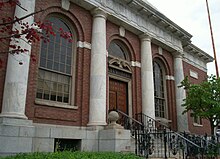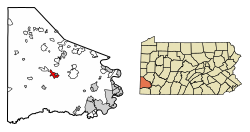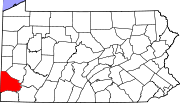|
Washington, Pennsylvania
Washington is a city in, and the county seat of, Washington County, Pennsylvania, United States.[4] The population was 13,176 at the time of the 2020 census.[5] Part of the Pittsburgh metropolitan area in the southwestern part of the state, the city is home to Washington & Jefferson College and Pony League baseball. History  Delaware Indian chief Tangooqua, commonly known as "Catfish", had a camp on a branch of Chartiers Creek, in what is now part of the city of Washington.[6] The French labeled the area "Wissameking", meaning "catfish place", as early as 1757.[6] 18th centuryThe area of Washington was settled by many immigrants from Scotland and the north of Ireland along with settlers from eastern and central parts of the Colony of Virginia, first settled around 1768. The Pennsylvania General Assembly passed an act on March 28, 1781, establishing the County of Washington and naming "Catfish Camp" as the place for holding the first election. It was the first county in the U.S. to be named in honor of George Washington, commander of the Continental Army during the American Revolutionary War and the nation's first president. David Hoge laid out a plan of lots immediately after the legislature's action. His original plot carried the name "Bassett, alias Dandridge Town," but before the plot was recorded, lines were drawn through "Bassett, alias Dandridge Town" with ink, and the word "Washington" was written above. There have long been rumors among locals that the town was named Washington because George Washington spent the night in the region once. This is not true however; Washington had never been to the area. The original plot dedicated a tract of ground to the people for recreational purposes. A lot was given for a courthouse where the current building now stands, and Lots 43 and 102, according to the plan, were presented by Hoge to "His Excellency, General Washington, and Mrs. Washington." Washington, Pennsylvania, was the center for the 'Whiskey Rebellion' of 1791, which was one of the first open rebellions against the new U.S. government and Constitution. The rebellion was centered on a tax being imposed on whiskey distillation in the region. The house of David Bradford, one of the leaders of the rebellion, is now a museum devoted to the Whiskey Rebellion, the David Bradford House, located on South Main Street of the city. 19th centuryThe town was incorporated as a borough on February 13, 1810, and became a class three-sized city in 1924.[7] In August 1875, construction began of the 3 ft (914 mm) Waynesburg and Washington Railroad, conceived by John Day in 1874 and chartered in 1875.[8] Passenger services ended in 1929, conversion to standard gauge followed in 1944, when it was renamed the Waynesburg Secondary. Freight services ended in 1976, although part of the line still survives for access to a coal mine. The discovery of oil and natural gas at the Washington oil field caused a boom period from the 1880s to the early 1900s. James B. Wilson chartered the Washington Electric Street Railways in 1889 with construction beginning in November 1890. The first line was built from the Waynesburg and Washington Narrow Gauge station to Wilson Orchard, just north of the present day site of the UPMC Washington hospital.[9] 20th centuryIn 1903, the Washington and Canonsburg Railway Company linked Washington to Canonsburg, Pennsylvania with a trolley line. The company was bought by the Philadelphia Company in 1906, later becoming part of the Pittsburgh Railway Company, linking through to Pittsburgh as part of their interurban service in 1909.[10] The line closed on August 29, 1953. A short section of the line and a number of trolley cars are preserved at the Pennsylvania Trolley Museum north of the city. GeographyAccording to the U.S. Census Bureau, Washington has a total area of 3.3 square miles (8.5 km2), all land.[11] ClimateWashington is located in a transition between a humid continental climate (Köppen Dfb) and a humid subtropical climate (Köppen Cfa), with warm to hot and humid summers and cold, snowy winters. Precipitation is highest in the summer months, with an annual average of 38.87 in (987 mm). Snow usually falls between November and April, with an average of 37.8 in (96 cm).
Demographics
As of the census[14] of 2010, there were 13,663 people living in the city. The population density was 4,140.3 people per square mile. The racial makeup of the city was (10,373) 75.92% White, (2,803) 20.52% African American,(131) 0.96% Asian, and (107) 0.78% from other races. Hispanic or Latino of any race were (249) 1.82% of the population. As of the census[14] of 2000, there were 15,268 people, 6,259 households, and 3,486 families living in the city. The population density was 5,199.2 people per square mile (2,007.4 people/km2). There were 7,111 housing units at an average density of 2,421.5 per square mile (934.9/km2). The racial makeup of the city was 81.88% White, 14.60% African American, 0.15% Native American, 0.45% Asian, 0.02% Pacific Islander, 0.61% from other races, and 2.29% from two or more races. Hispanic or Latino of any race were 0.94% of the population. There were 6,259 households, out of which 24.3% had children under the age of 18 living with them, 34.7% were married couples living together, 17.1% had a female householder with no husband present, and 44.3% were non-families. 38.0% of all households were made up of individuals, and 15.8% had someone living alone who was 65 years of age or older. The average household size was 2.20 and the average family size was 2.91. In the city, the population was spread out, with 21.2% under the age of 18, 13.2% from 18 to 24, 28.0% from 25 to 44, 20.9% from 45 to 64, and 16.7% who were 65 years of age or older. The median age was 36 years. For every 100 females, there were 88.3 males. For every 100 females age 18 and over, there were 84.6 males. The median income for a household in the city was $25,764, and the median income for a family was $34,862. Males had a median income of $29,977 versus $22,374 for females. The per capita income for the city was $14,818. 20.7% of the population and 16.4% of families were below the poverty line. Out of the total population, 29.2% of those under the age of 18 and 15.8% of those 65 and older were living below the poverty line. ReligionFounded in 1891, Beth Israel Congregation is the only synagogue in Washington County. Economy Major employers in Washington include The Washington Hospital, the government of Washington County, and Washington & Jefferson College.[15] Arts and culture Washington Symphony Orchestra, founded 2002, offers four to five concerts annually.[16] The Washington Community Theatre presents several musicals and other productions throughout the year, with a feature production held each June in the Main Pavilion at Washington Park. WCT celebrated its 40th anniversary in 2009.[17] Also in the city are two historic homes, that of David Bradford on South Main Street and that of F. Julius LeMoyne on East Maiden Street. Bradford's home was later the birthplace of American realist author Rebecca Harding Davis in 1831. LeMoyne was an ardent abolitionist whose home was part of the Underground Railroad; LeMoyne was a doctor who also built the first crematory in America. The David Bradford House and F. Julius LeMoyne House are listed on the National Register of Historic Places, along with the Administration Building, Washington and Jefferson College, Dr. Joseph Maurer House, Pennsylvania Railroad Freight Station, Washington Armory, Washington County Courthouse, and Washington County Jail.[18] Washington is home to PONY Baseball and Softball's headquarters and the annual PONY League World Series (for 13- and 14-year-old players).[19] The PONY League World Series is held at historic Lew Hays Field located in the city's Washington Park. The Washington Wild Things minor league baseball team has been based out of the city since 1997. On January 27, 2006, to commemorate the Pittsburgh Steelers' appearance in Super Bowl XL, the city council voted to symbolically rename the city "Steelers, Pennsylvania" through February 5, 2006.[20] Education Washington is home to Washington & Jefferson College, a small, co-educational private liberal arts college which traces its origin to three log cabin colleges in Washington County established by three Presbyterian missionaries to the American frontier in the 1780s. The modern institution was established in 1865 from the merger of Washington College in Washington and Jefferson College in Canonsburg.[21] Located in downtown Washington, the college enrolls approximately 1,500 students. The 60-acre (0.24 km2) campus has more than 40 buildings, with the oldest dating to 1793. The college's academic emphasis is on the liberal arts and the sciences, with a focus on preparing students for graduate and professional schools. Washington & Jefferson College typically places within the top 100 or first tier of ranked liberal arts colleges.[22][23][24] Washington is served by the public Washington School District, which includes four schools; Washington High School (grades 9–12), Washington Junior High School (grades 7–8), Washington Park Intermediate School (grades 4–6), and Washington Park Elementary School (grades K-3), in addition to an alternative online environment.[25] MediaThe Observer-Reporter is a daily newspaper founded in 1808. Washington's commercial radio station is WJPA (95.3 FM / 1450 AM). Notable people
See alsoReferences
External linksWikimedia Commons has media related to Washington, Pennsylvania.
|
||||||||||||||||||||||||||||||||||||||||||||||||||||||||||||||||||||||||||||||||||||||||||||||||||||||||||||||||||||||||||||||||||||||||||||||||||||||||||||||||||||||||||||||||||||||||||||||||||||||||||||||||||||||||||||||||||||||||||||||||||||||||||||||||||||||||||||||||||||||||||||||||||||||||||||||||||||||||||||||






